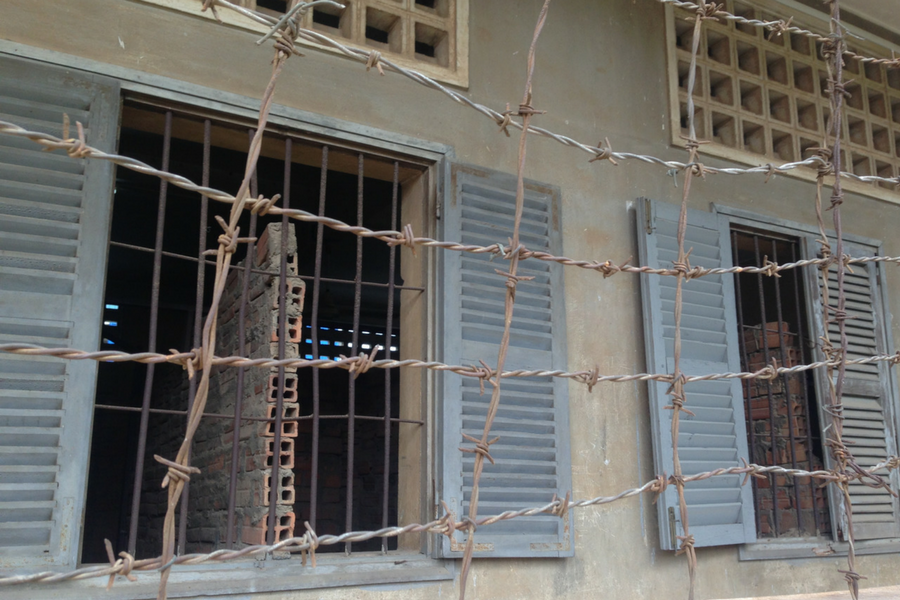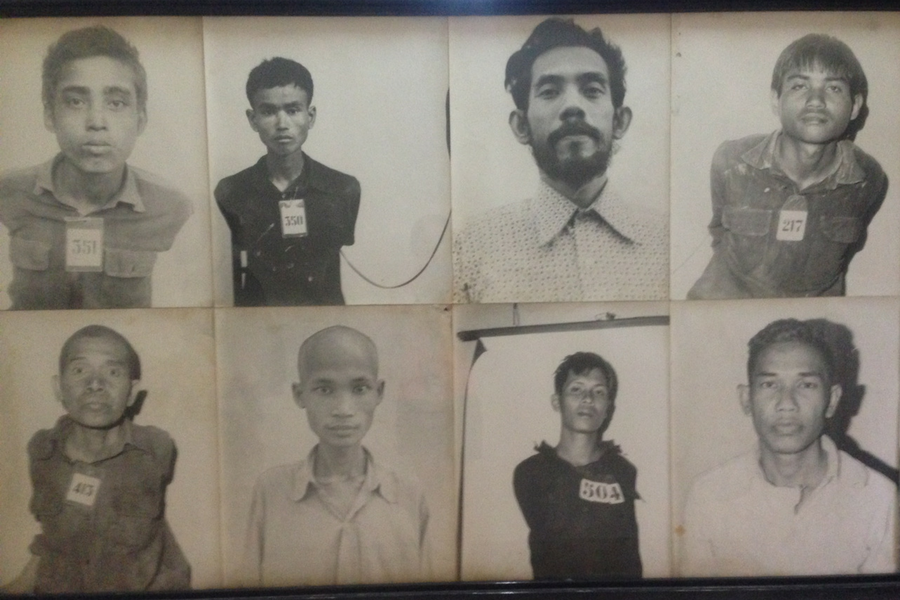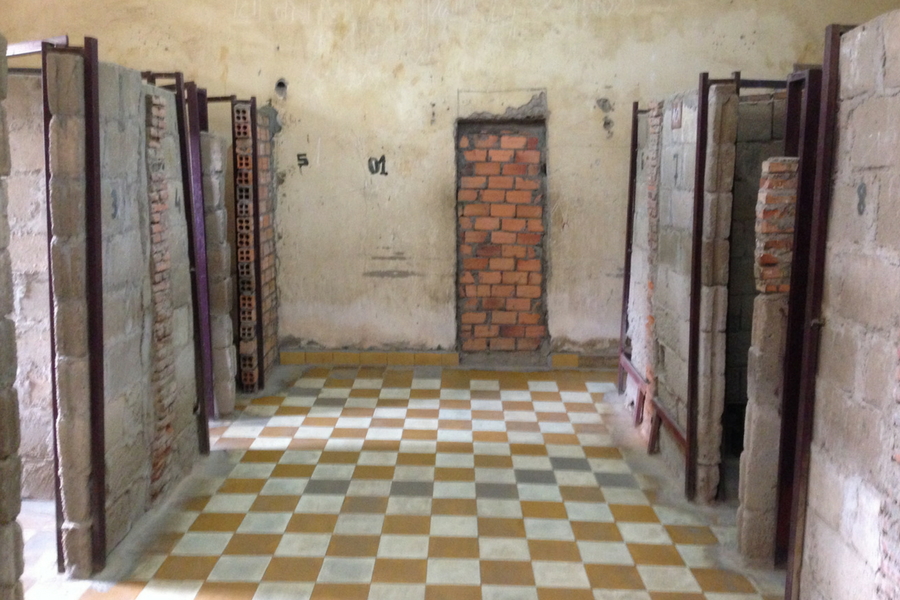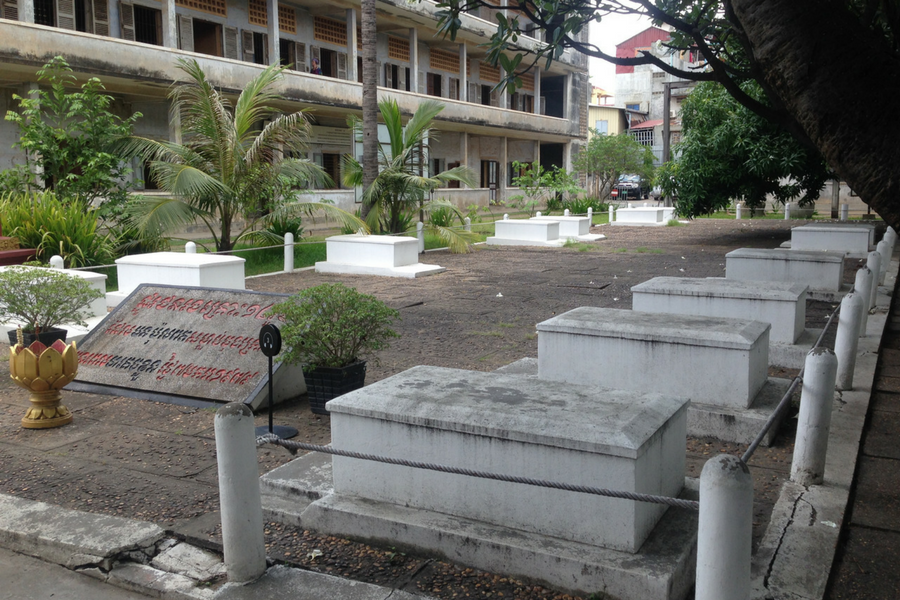If we’re being honest, this atrocity is something that seems to get overlooked in the American school system. In fact, I feel that I, other students in America, and the Cambodian people have been done a huge disservice. It’s important that we remember and recognize the following events as truth. That’s how we learn to never again turn a blind eye to what is so clearly evil.
I had the privilege of visiting the Killing Cave in Battambang as well as Tuol Sleng Prison in Phnom Penh. There was so much new information to absorb, I thought my head might explode. I decided to do my own internet research and, as it turns out, there are very few reliable sources. The history of the Khmer Rouge is cluttered and messy and you’ll find hundreds of stories from various victims and witnesses. I had to check and double check claims, and search various different sites before I could put a whole story together, but finally I did. The following is a summary of the rise, reign and fall of the Khmer Rouge.
WAR ENDS. NEW REGIME BEGINS.
To fully understand the history, we have to go back to the Vietnam war.
During the war, the U.S. bombed parts of Cambodia, trying to seek out and eliminate Vietcong troops that may have been hiding across the border. The U.S. also believed that the Cambodians may be joining forces with the Vietnamese communists. [1] As you can imagine, this led to many Cambodians losing their lives, and they didn’t appreciate our presence in their country. The Cambodian people wanted U.S. troops out, but their new leader, Lon Nol allowed both U.S. and South Vietnam troops to operate in Cambodian territory [2]. In 1971, Lon Nol suffered a stroke and his health was in decline. Many of his people believed he was unreliable and Cambodia was weakening under his rule. There was much unrest in Cambodia, which likely led to the initial popularity of the rebel forces – the Khmer Rouge. Many Cambodians who were effected by the U.S. bombings, joined the Khmer Rouge, and by early 1973, 85% of Cambodia was under the control of the KR [3]. The enemy of my enemy is my friend, right? Not always, and certainly not this time.

The U.S. withdrew forces in 1973 and declared an end to the war, but fighting continued in Vietnam and Cambodia until 1975 [4] when on April 17th, Phom Penh was overtaken by the KR [3] and on April 30th, South Vietnam surrendered to the Northern Vietnamese communists [5].
This may not sound like a happy ending to us, but to the Cambodians who just wanted peace, they heard “war is over” and thought that all of their troubles were over as well. In reality, their troubles were only beginning…
LIES OF THE KHMER ROUGE
No sooner had the citizens of Cambodia begun their “end of war” celebration that the Khmer Rouge soldiers began entering the cities. City people, or “New People” as they were known, were forced into the countryside by soldiers. Some were told this was a temporary safety measure because there would be another “American bombing” and the people believed it. [6] Why wouldn’t they? It wasn’t the first bomb to drop. Little did they know, they wouldn’t be returning home as the soldiers promised.
Other Cambodians were forced out of the city against their will- if they refused, they were killed. Regardless of the reason for complying, the journey was difficult and supplies for the travelers were limited, as was medical care. Between 2,000 and 3,000 died on the journey alone – some died of starvation, others of exhaustion or disease, and many others yet died in childbirth. [7] Along the way, evacuees were deliberately separated from their families by the Khmer Rouge, which was only the beginning of the psychological torture that was to come. One survivor recounted, that along the journey to the countryside, her family slept through the night amidst the dead bodies of other evacuees without realizing it [8].
This was only the start of a rise to communism – and the evacuees were now slaves to the new regime. Forced to become agricultural laborers, the people began dying of starvation and exhaustion. None of the “new people” knew how to farm rice, and neither did the soldiers, so the yield was low and there was not enough food to feed the Cambodian people. Foolishly, the KR soldiers forced the people to work longer days, thinking that would solve the problem, but ultimately it only served to kill more laborers [9].
Other citizens were tricked into traveling with the soldiers, believing they were being brought to a school to teach or being reunited with lost family members. They had no idea what tragedies lay ahead. The Angka (the ruling body of the Khmer Rouge) was still new, and as far as the people knew, they were trying to help rebuild Cambodia. Perhaps, in their own minds, that is what they were doing.

They were communists. And they wanted to eliminate all outside influence. They closed schools, hospitals and banks. They burned books and currency and outlawed religion. Fishing and gathering food was considered “private enterprise” and was punishable by death [10].
LIFE IN TUOL SLENG PRISON
In Tuol Sleng prison, the victims were photographed. In the beginning of the Khmer Rouge reign, they were photographed with their names around their necks – slowly but surely, they “upgraded” to a number system to help with the de-humanizing process. Sadly, it the most mild de-humanizing tactic.

The typical victim was an educated person – man or woman. Doctors, engineers, teachers.. education was considered a threat to Angka [10]. If an educated man had a wife and family, they’d often imprison, torture and kill his wife and children as well. Their way of justifying this act?
“When pulling a weed, you must pull out all the roots”[11].
Demented poetry.
In the prisons, people were coerced into writing confessions so that the Khmer Rouge had paperwork “proving” the citizen’s guilt [12]. Pol Pot, the leader of the regime, had strict rules on how prisoners were to be tortured and when they were to be killed. Prisoners were hung upside down and dunked into buckets of human waste, waterboarded, beaten, and much more. One witness testified that a woman was hung from a hook, disemboweled, and her organs were consumed by Khmer Rouge security officials while other prisoners were made to sit and watch [13].
Some prisoners had their own small cell, others were shackled ankle-to-ankle with around 40 prisoners and made to lay on their backs in a large room. If they spoke to each other, they were beaten. Sometimes the guards would spray them with a hose through the bars on the window. This was their “shower”. Some got no water at all and others were drenched. They were forced to strip each time and were humiliated by the laughing guards. After the shower, they were made to wipe up the excess water with their shorts. Still wet afterwards, many of the prisoners developed sores and other skin diseases. [14]
THE REST OF THE WORLD
How did other countries respond? It took a while before there even came a whisper about violence in Cambodia and even after information started leaking, The Khmer Rouge kept their seat at the UN as the representative for Cambodia for years. Scholars have many theories about why the rest of the world stood by for so long while the Cambodian people suffered, but a large factor was likely the lack of “hard evidence”. No journalists were allowed into Cambodia and the only way information was received was through the few victims who fled. Perhaps it was easier to pretend the reports were false than to look further into them.

In 1978 the Vietnamese invaded and ousted the Khmer Rouge – the remaining prisoners (those who were not slaughtered just before the Khmer Rouge fled) were liberated, beginning 11 years of Vietnamese occupation[16]. But the Khmer Rouge did not die off. In fact, because of their fight against Vietnam, they received support from the U.S. and China – both countries that were none to happy about Vietnam’s alliance with the Soviet Union. The U.S., of course, didn’t offer direct assistance – but they backed China in supplying the KR with military equipment. As president Carter’s National Security Officer later admitted,
“I encouraged the Chinese to support Pol Pot. The question was how to help the Cambodian people. Pol pot was an abomination. We could never support him, but China could”[15].
What the…? Yeah, that’s a real quote.
1979 was the year Cambodia’s UN seat was granted to the Khmer Rouge and investigations of Khmer Rouge crimes ceased – the KR continued, miraculously, to hold their seat until 1993. No foreign aid was offered to Cambodia. The United States warned other countries not to offer assistance, presumably because they wanted nothing to do with the Vietnamese. [15]
The 80’s were big years for epic U.S. fails. Throughout the 1980’s the Reagan administration blocked the efforts to label the actions of the Khmer Rouge as “genocide”. In fact, in 1980, the U.S. used its influence on the World Food Program to send $12 million worth of food to the Khmer Rouge to help restore the fighting force and become a good ally for the Cold War [17]. The genocide had ended and the remaining prisoners were free, so… I guess that means everything is cool now, right? Uh….
In 1989, the U.S. and Japan both thwarted the UN’s initial plans to send a team into Cambodia to investigate reports of malnutrition in 20% of children [15].
It wasn’t until the early 90’s that the UN became more heavily involved and tried to bring about justice. In 1991, an agreement called the “Paris Peace Accords” also known as the “Comprehensive Cambodian peace agreement” was signed by ambassadors of the U.S. and Vietnam. The agreement was that all foreign military forces would vacate Cambodia, the Cambodian people would have a right to free and fair elections, and refugees would be returned to their country on a voluntary basis. Now we are getting somewhere.. [18]
THE TRIBUNAL
In ’97 Cambodia’s prime ministers requested assistance from the UN to set up trials against Khmer Rouge leaders. It wasn’t until 2003 that an agreement was made and approved by the UN general assembly. So began the Cambodian Tribunal, a national court meant to try the Khmer Rouge’s most senior members. [19]
However, it was slow going, due to – as the Cambodian government claimed – lack of funding. It wasn’t until 2006 that the 7 judges, Cambodian and United Nations, were nominated. [19] Trials began in 2007 and some indictments were made, but many trials remain unfinished.
There is some controversy about the effectiveness of this court. Some feel they are trying to bury the case and that perhaps the court should have been held in another country, to avoid corruption [20]. A former Khmer Rouge commander still lives freely in Battambang province today, thanks to 3 Cambodian judges on the panel defending his “honor”, and he is not the only one. Other active participants in the Khmer Rouge still wander Cambodia as free-men to this day, as judicial police refuse to arrest them. A couple of the judges resigned after the panel started receiving criticism which caused even more doubt about the panel’s ability to perform its duty. [21]
There were however, many indictments. But to the dismay of many, Pol Pot, the leader of the Khmer Rouge, died before his fate could be decided. The circumstances of his death are uncertain and the timing did seem coincidental, at best. Some speculate he may have killed himself or was murdered, but his wife claims “he died peacefully in his sleep”. Perhaps to save face? Who knows. Either way, many feel justice wasn’t served as he never truly had to pay for his crimes. Not to mention, many feel his “apologies” were not genuine and he never truly accepted responsibility for the horrendous crimes committed. In a magazine interview in 1997, he stated,
“The babies, the young ones.. I did not order them to be killed.” He said to the interviewer, “Even now, and you can look at me – am I a savage person?” [22]
Many other members of the Khmer Rouge followed suit in passing the buck, stating that they were only trying to stay alive, and would have been killed if they disobeyed the regime. One surviving victim said,
“They always say they did nothing wrong, they only followed orders and it’s not their fault. I don’t want to hear them say they followed orders and did their job”. [12]
Before the Khmer Rouge fled Phnom Penh, they were ordered to kill all prisoners and dispose of their bodies. They left 14 bodies behind. These are their graves.[/caption]
An exact death toll for this tragic historical event is not known and likely never will be. It is estimated that 1.7 million Cambodians died of overwork, starvation or murder – but other estimates put that number even higher. Of the 14,000 known prisoners housed at Tuol Sleng, only 7 survived. [23]. Over 20,000 mass graves have been found to date – there may be more undiscovered.
The official “end” of the Khmer Rouge wasn’t until 1999, after Pol Pot’s death. The prisoners may have been freed in 1978, but guerrilla fighting continued for many years after. [24] It’s not hard to see why many Cambodians to this day are still deeply effected by the actions of the Khmer Rouge. This is not ancient history.

QUESTIONS
What do you think?…
Would things have been different if the U.S. hadn’t fell through on it’s promise to continue to assist South Vietnam in fighting communism?
Why do you think it was so easy to ignore the Cambodian suffering?
Could you foresee something similar happening in the future?
Share your thoughts with us.


